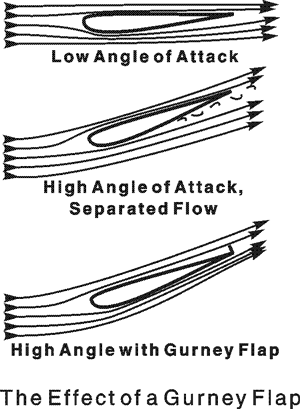INSIDE
RACING
T E C H N O L O G Y
IRT Home
IRT Home
News Page
Contents Page
Newsletter &
Books
email Paul
Race Tech 104: Gurney Flap
What’s a Gurney?
If you’ve watched Champ Car or IRL races on TV, you’ve probably heard a pit reporter mention that a crew member made a change to the “Gurney” during a pit stop. I’ve heard Gary Gerould, one of the best of the TV announcers, explain that this “Gurney” is a device the teams use to adjust the downforce generated by the wing.
Gerould is correct, of course, but in aerodynamic terms that “Gurney”, also called a “Gurney flap” or “wickerbill,” is a trailing edge flap. Airplanes use flaps for increased lift during takeoff and landings. Dan Gurney’s Eagles were the first to use a trailing edge flap at the Indy 500 in the early 1970s and his name stuck to the device. A trailing edge flap improves the performance of a wing at high angles of attack. Here are some sketches to show what’s going on.
The first sketch shows an upside down wing which generates downforce or negative lift as it moves through the air. The air has to accelerate to go around the rounded side of the wing and loses pressure when it speeds up. As you remember, Bernoulli’s Theorem says at any place in a fluid, you get the same value when you add up the static and dynamic pressure (what you feel when you put your hand out the window of a moving car). A still fluid has no motion and no dynamic pressure. The slower air on top is at a higher pressure and presses down on the wing surface. The force a wing produces depends on the airfoil shape, the area of the wing, and the square of its speed through the air.

The second sketch is a wing at a high angle of attack. At high angles of attack, air is unable to follow the contour of the lower wing surface and can detach, lowering the efficiency of the wing. As a result, downforce goes down and drag goes up. A small lip on the trailing edge, shown in the bottom sketch, causes a lower pressure just behind it which sucks the lower flow back up to the wing surface. The Gurney flap causes some extra drag, but the wing can be run at a higher angle of attack and produces more downforce.
You can only hang so much wing on a racecar because of rules limiting the number and dimensions of wings or just by running out of room. Those pesky radiators and tires get in the way and they just can’t be left out. A designer has to get all the downforce possible out of the wing surfaces allowed by the rules. A Gurney gets more downforce from the allowable wings because you can run them at higher angles of attack.
A Gurney is also used as a quick way to fine tune the force
a wing generates in order to adjust the way a car handles. Varying
the height of the Gurney adjusts downforce (and drag, of course)
and race teams have devised ways of changing the Gurney quickly.
L-shaped aluminum extrusions are available in various sizes,
and the rear wings are made so these extrusions can be quickly
inserted from the side into a groove in the wing during a pit
stop. Some teams use lengths of 4 or 6 inch diameter white plastic
water pipe with caps on each end to store and transport their
Gurneys.